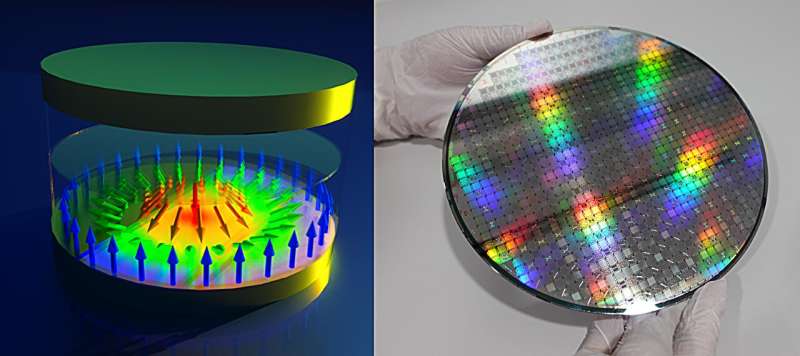This article has been reviewed according to Science X's editorial process and policies. Editors have highlighted the following attributes while ensuring the content's credibility:
fact-checked
peer-reviewed publication
trusted source
proofread
Researchers create skyrmion-based memory technology for extremely low-power devices

A research team led by the Agency for Science, Technology and Research (A*STAR) in partnership with National University of Singapore (NUS) has created an innovative microelectronic device that can potentially function as a sustainable, high-performance "bit-switch." This paves the way for future computing technologies to process data much faster while using significantly less energy.
By harnessing tiny, stable and speedy magnetic whirls called skyrmions, the device can operate using 1,000 times less power than commercial memory technologies. This discovery was reported in the journal Nature.
The need for more sustainable and efficient AI computing
Emerging AI technologies such as ChatGPT require large amounts of data to be processed at blazing speeds, which draw on immense computing power. Infocomm technologies already consume nearly 20% of global electricity, which is set to spike even further with the growth of such large AI models. To meet these rapidly growing demands, the fundamental computing "switch," or memory-bit , has been scaled down to ever-smaller sizes, and is approaching its physical limits.
A prominent approach to mitigate this energy crisis, especially for mobility, health care and manufacturing domains, is edge computing. Here, data is processed within individual appliances, such as phones, smart home appliances and vehicles, rather than in power-intensive large-scale data centers. However, edge appliances are presently unable to perform complex computational tasks due to limited computing capacity and power constraints. There is a pressing need to develop a radically different microelectronic platform in order to achieve efficient and sustainable AI computing.
Activating the potential of skyrmions
Skyrmions are tiny magnetic whirls—10,000 times smaller than the width of a human hair—that form within specific magnetic layers when they are made extremely thin. Discovered only a decade ago, these whirls can be extremely stable and compact, and can be efficiently moved between magnetic regions. They form ideal mobile switches for efficient, large-scale data processing for AI technologies.

To tap on the vast potential of skyrmions, it is critical to access them using electrical pathways such as those employed in computers. While skyrmions can be seen under special microscopes and have been manipulated using bulky magnets for over a decade, the absence of electrical control has been a critical impediment to their technological relevance.
The team's breakthrough is the first to achieve electrical readout ("identification") of a skyrmion and electrical switching between states (e.g., "0" to "1," and vice versa). To do so, the team employed a device known as a tunnel junction, which is operable under ambient conditions and used extensively in commercial memory and hard disk applications.
They discovered that the special attributes of skyrmions enable the switching between states using 1,000 times less power than commercial devices. They also found that more than two states can be achieved within a single device, which circumvents the need to scale down the device size for enhanced performance.
Future directions
"Skyrmions have unique and elusive attributes that can be exploited to implement various AI architectures with unprecedented efficiency and functionality. Our microelectronic device provides the long-awaited key to unlocking their vast potential. It will help cement skyrmions as an integral component for the future of computing," said the team leader Dr. Anjan Soumyanarayanan, Principal Scientist at A*STAR's Institute of Materials Research and Engineering (IMRE) and Assistant Professor at the NUS Faculty of Science's Department of Physics.
"Our microelectronic devices are fabricated on 200 mm silicon wafers using materials and methods readily employed in existing microelectronic foundries in Singapore and globally. We hope to collaborate with the electronics cluster ecosystem to accelerate the practical integration of these devices with existing edge computing technologies," said Dr. James Lourembam, Senior Scientist at IMRE's Electronic Materials Department.
The team hopes that with further refinement of the electrical performance, the enhanced computing switch can be readily integrated into microprocessors using established approaches. The team is looking to collaborate with semiconductor manufacturing companies and system integrators to scale up the technology for wider adoption.
More information: Shaohai Chen et al, All-electrical skyrmionic magnetic tunnel junction, Nature (2024). DOI: 10.1038/s41586-024-07131-7


















